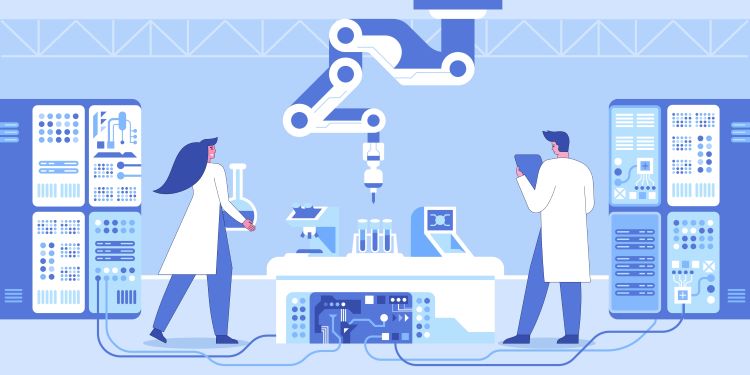Research outlines framework for robotic laboratory automation
Posted: 24 May 2023 | Catherine Eckford (European Pharmaceutical Review) | No comments yet
A paper has discussed a laboratory automation plug & play (LAPP) framework, of which a digital twin layer plays an important part.


Research proposing a digital twin (DT) based approach has outlined the types of information required for components in a laboratory automation plug & play (LAPP) framework.
This system provides overall recommendations for integrating robots into life science laboratories.
The paper stated that the framework aims to simplify the integration and set-up process for these types of robots by removing the requirement for manual configuration by the user in addition to teaching of the robots.
Robot-based laboratory automation
For plug & play functionality to be possible, a series of complementary technologies must be consolidated and integrated into a comprehensive stack. Since compatibility is a key factor, established and widespread standardised solutions are preferred, the paper recommended.
Setting up a robot-based laboratory automation system begins with representing the process on the high-level to enable execution on an all-round process controller, noted the authors. Representation formats, such as the Business Process Model and Notation (BPMN) and the Laboratory Open Protocol (LabOP) were highlighted in the paper.
The Robot Operating System (ROS) was suggested as a versatile robot control capable of incorporating advanced techniques for perception, navigation and motion planning.
An essential part of the LAPP framework, stated the authors, is the digital twin (DT) layer. This allows for the robot-relevant information to be stored and shared in regard to the various components of the system. Most importantly, the positions for arm control must be stored in a standardised fashion (encoded in the DT) and provided with the device out-of-the-box.
A mobile manipulator (MoMa) can be considered as the most complex robot system detailed in the paper, which represents the broadest variety of components, wrote Wolf et al.
The LAPP framework focuses at first on a specific type of MoMa that is now used by multiple solution providers for sample transportation in automated laboratories. For this, the typical lab automation MoMa anatomy is considered.
The authors listed the components for these robots:
- A wheeled autonomous mobile base capable of simultaneous localisation and mapping (SLAM)
- A robot arm of four to seven degrees of freedom (DoF)
- A vision system that aids the fine position detection for gripping and manipulation planning.
Traditional laboratory robots are usually taught in joint-space. The robot configuration is stored directly in the form of joint values for each position. The outcome of this is that the accuracy of the robot’s kinematic model is not vitally important.
In contrast, when the positions are specified in world coordinates, the robot controller must perform the inverse kinematics calculations to determine the corresponding joint values. For this, the robot’s geometry must be precisely modelled, reported Wolf et al.
To achieve the sub-millimeter precision required for efficient and reliable plate manipulation, re-calibrated of the robot must be left open as an option”
These are specified initially for each robot model during the design process. Following the DT notation, these data correspond to the DT prototype of the robot model. Due to manufacturing imperfections, however, each piece of a finished robot has slightly different geometries. These must be readjusted through calibration. These new parameters are stored in the digital twin instance for the certain robot. To achieve the sub-millimeter precision required for efficient and reliable plate manipulation, re-calibrated of the robot must be left open as an option.
For the devices interfacing with the robot, the robot positions must be defined beforehand in a device-attached coordinate system (CS) by the vendor.
The CS must be detectable by the vision system of the robot by optical markers placed on the front side of the device. This way, the robot is capable of tending the machine by performing the pick-and-place type transportation of standard sample carriers.
This basic use case is the primary scope of the LAPP-DT framework. The hardware scope is limited to simple benchtop and mobile manipulators with parallel grippers at this stage, according to Wolf et al.
Online versus offline teaching of lab automated robots
Another distinction is between online vs. offline teaching. Online teaching means that the positions are taught directly on the physical robot by moving its end-effector to the desired positions manually. In this case, the robot’s repeatability is more important than its absolute accuracy. The robot should be consistent even if systematic error is present, the research stated.
Offline teaching means that the positions are defined without the physical robot, for example, in the case of the LAPP approach by the device vendor. In this case, the absolute accuracy is just as important as the repeatability, since consistency is not sufficient if the position is off. Therefore, the precision requirements towards a LAPP-enabled robot must be formulated adequately. The paper also highlighted the digital twin closeness required to measure such precision in digital twin-based offline teaching scenarios.
This research was funded by Baxalta Innovations GmbH, a Takeda company.
Related topics
Big Pharma, Drug Development, Lab Automation, Lab Equipment, Research & Development (R&D), Robotics, Technology









